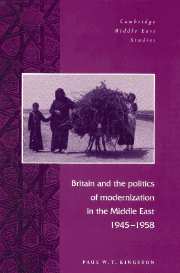Book contents
- Frontmatter
- Contents
- Acknowledgements
- Introduction
- 1 Britain, peasants, and pashas: debating approaches to modernization in the postwar Middle East
- 2 Imperial dreams and delusions: the economics of promoting Middle East modernization
- 3 The British Middle East Office and the abandonment of imperial approaches to modernization
- 4 The British Middle East Office and the politics of modernization in Iran, 1945 to 1951
- 5 The British Middle East Office and the politics of modernization in Iraq, 1945 to 1958
- 6 The British Middle East Office and the politics of modernization in Jordan, 1951 to 1958
- Conclusion: ‘hastening slowly’
- Notes
- Bibliography
- Index
6 - The British Middle East Office and the politics of modernization in Jordan, 1951 to 1958
Published online by Cambridge University Press: 09 October 2009
- Frontmatter
- Contents
- Acknowledgements
- Introduction
- 1 Britain, peasants, and pashas: debating approaches to modernization in the postwar Middle East
- 2 Imperial dreams and delusions: the economics of promoting Middle East modernization
- 3 The British Middle East Office and the abandonment of imperial approaches to modernization
- 4 The British Middle East Office and the politics of modernization in Iran, 1945 to 1951
- 5 The British Middle East Office and the politics of modernization in Iraq, 1945 to 1958
- 6 The British Middle East Office and the politics of modernization in Jordan, 1951 to 1958
- Conclusion: ‘hastening slowly’
- Notes
- Bibliography
- Index
Summary
Transjordan was the most artificial of the states created in the wake of the First World War. Born out of a temporary agreement between Amir Abdullah and Britain in 1921, it has proved resilient in the face of the various domestic and regional tensions that have threatened its existence. In part, this was due to Abdullah's ability to establish a viable form of patrimonial rule based on a series of alliances with Sharifian, Palestinian, Syrian, and Circassian expatriate élites which gave him some degree of independence from the indigenous social, mainly tribal, forces of the region. Ultimately, however, Transjordan (or Jordan as it became in 1945 after the signing of the Anglo-Jordanian Treaty which established Jordan's independence) owed its existence to the financial, military, and diplomatic support of Britain. As Mary Wilson has written, ‘it had no reason to be a state on its own … except that it better served Britain's interests to be so’.
This tenuous viability, however, was increasingly threatened in the volatile postwar world of the Middle East. The regional prestige and influence of Britain, Jordan's long-time patron, was beginning its precipitous decline, symbolized most dramatically by its decision to withdraw from Palestine in 1947, though this paradoxically resulted in an increase in the relative importance of Jordan in British strategic thinking. More serious for Jordan, however, was the disastrous outcome of the war in Palestine which resulted, among other things, in the tripling of Jordan's population due to the influx of Palestinian refugees and the incorporation of West Bank Palestinians into the country in 1950.
- Type
- Chapter
- Information
- Publisher: Cambridge University PressPrint publication year: 1996



